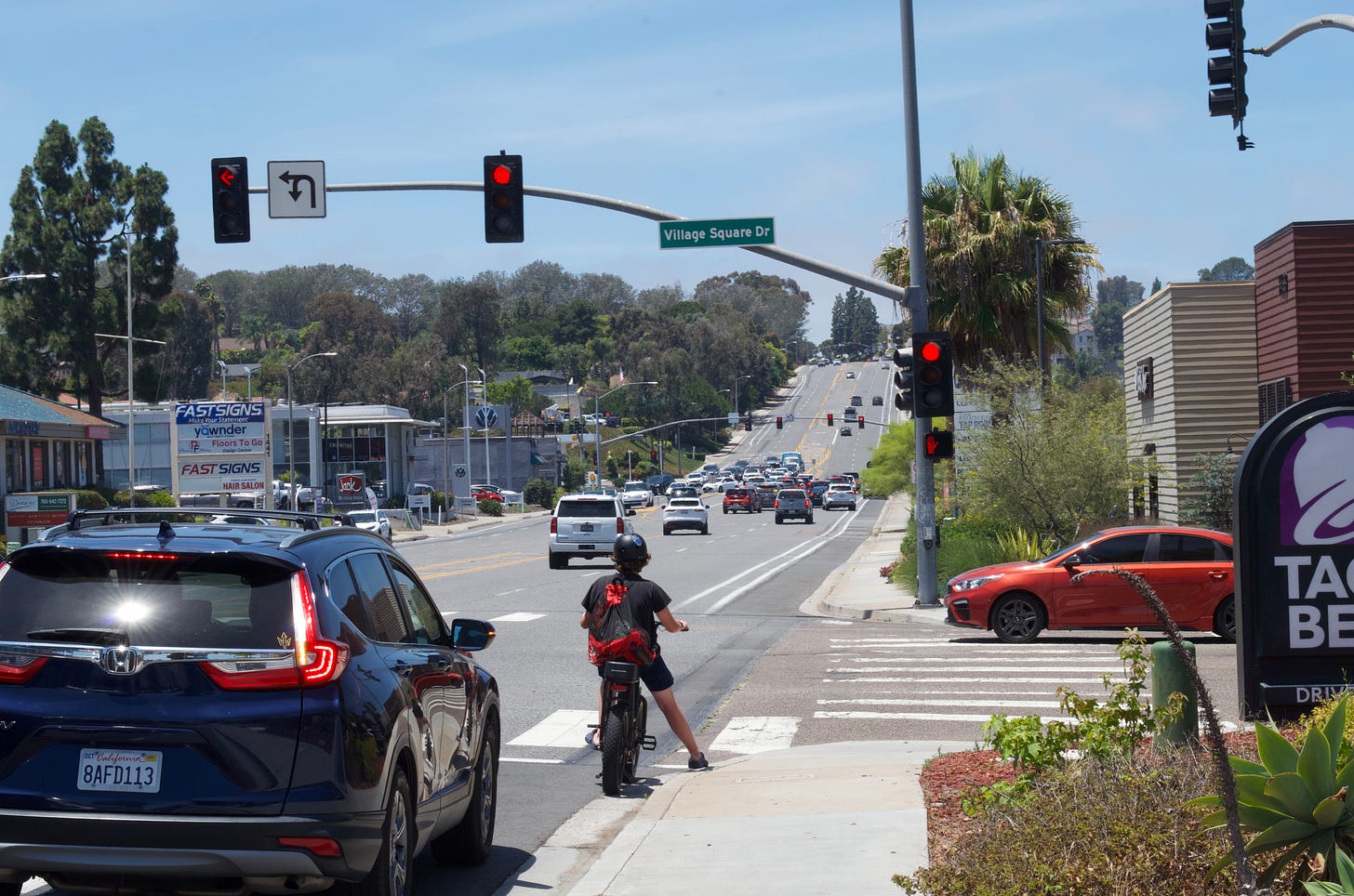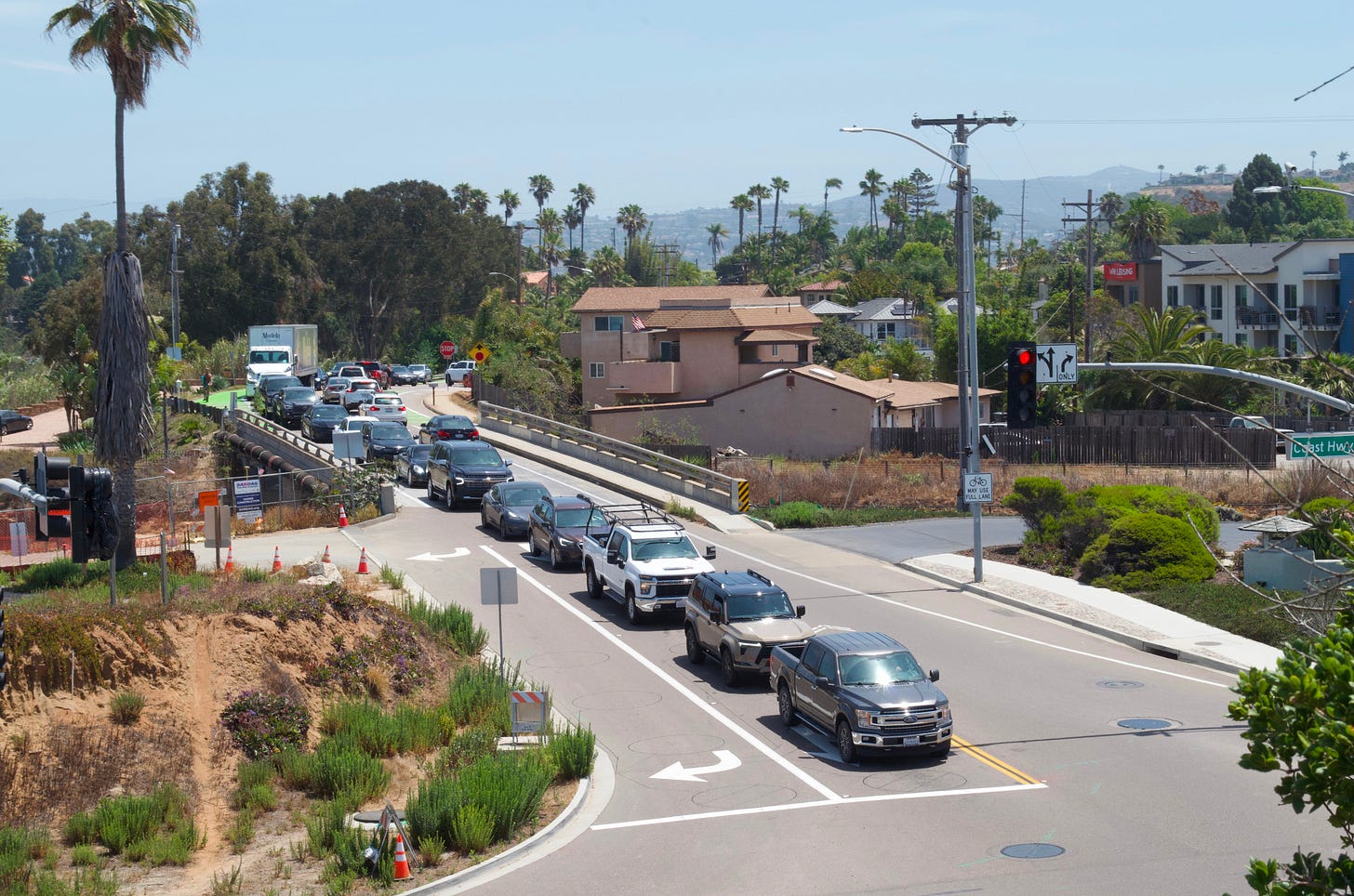Encinitas at a crossroads: a 'state of emergency' for traffic safety
City officials, grieving families, and residents demand safer streets. What's being done?
For the first week’s edition, I’ve decided to report on traffic safety. An admittedly banal, dry sounding subject before realizing the emotional and psychological weight it actually carries.
Fatalities, collisions, traffic — these elements pose significant challenges to a city grappling with rising density and aging infrastructure. So then, what is the City doing to address these concerns? And why does it seem to take such immense tragedy to get people — officials and residents alike — to march lockstep in finding solutions?
Death of 12-year-old sparks renewed calls for traffic safety reforms
Following the death of 12-year-old Emery Chalekian, city officials and residents in Encinitas are intensifying efforts to improve roadway safety and prevent future tragedies. Chalekian, a student at Park Dale Lane Elementary School, was fatally struck on April 25 at the intersection of Encinitas Boulevard and Village Square Drive, a heavily trafficked corridor known for speeding cars and a lack of adequate pedestrian safety measures — at least as long as I can remember.
The incident sparked widespread outcry and emotional appeal. At a May 21 Mobility & Traffic Safety Commission meeting, dozens of residents — many of them friends or neighbors of the Chalekian family — packed the room to demand urgent action, as I reported in the Coast News at the time. Their concerns centered on dangerous driving behavior, inadequate enforcement, and infrastructure deficiencies along one of the city’s busiest corridors.
“Every time we get into these seats, we have a huge responsibility to ourselves and the other drivers around us,” said Josh Armstrong, an Encinitas resident and friend of the Chalekian family. During the meeting, Armstrong accompanied his statements with video footage showing speeding and reckless driving around the site where Emery was struck by the car.

More recently, at a special joint meeting on June 25, the City Council and the Mobility and Traffic Safety Commission (MTSC) approved a revised 2024 work plan that outlines 10 priority projects and several new initiatives to address pedestrian and bicycle safety, traffic enforcement, and driver behavior.
But the cornerstone of the meeting wasn’t the report’s bureaucratic language or the declarations of intent contained therein — it came from the comments of John Chalekian, Emery’s father.
Marking exactly two months since his daughter’s death, Chalekian expressed profound frustration over the lack of visible action from the city in response. He acknowledged city officials’ personal empathy, but emphasized that words had not translated into meaningful policy changes.
“As a father of a child who was killed crossing a green intersection, it cuts deep to see no action,” Chalekian said, addressing the council and commission. “As a father of a nine-year-old who uses his feet and his … bike to go to school, it leaves me frightened and concerned and scared and angry. We lost a daughter, but this city lost a community member.”
Partly in response to these public comments, the council voted to agendize a formal declaration of a roadway safety state of emergency at a future meeting.
“I do want to propose to my council colleagues that we do declare a roadway safety state of emergency,” said Deputy Mayor Joy Lyndes. “We consider this a very, very high priority, and we're rallying behind solutions. I do want to express to the community that this rises to that higher level of a state of emergency.”
Roadway safety state of emergency?
This wouldn’t be the first time. In fact, as recently as 2023 a similar state of emergency was issued when 15-year-old Brodee Braxton Champlain-Kingman passed away after being struck by a car while on his e-bike.
But I — as I’m sure you — don’t really know what that means. I hear “state of emergency” and think The Simpsons Movie, EPA, and a big glass dome. In fact, during my conversation with Encinitas Mayor Bruce Ehlers during my reporting, he said he wasn’t quite sure what it meant either — just that it allowed for quicker, more decisive action to be taken by governing bodies during times of crisis.
“You know, that's a good question,” Ehlers said. “I may not be the one to give you the best answer.”
So, like any good reporter, I reached out to the Encinitas City Attorney's office for a clear, legal definition of the term. And like any good government department, they didn’t want to talk to me — I guess they’re afraid of telling me they don’t know what it means either.
But I did some digging. Turns out, under Section 2.50 of the Encinitas Municipal Code and the California Emergency Services Act, a local emergency may be declared by the director of emergency services — in this case, the city manager — when conditions of “extreme peril to the safety of persons and property” arise. The declaration must be ratified by the City Council within seven days to remain in effect.
In short, a local emergency declaration allows cities to bypass certain procedural hurdles, enabling them to act more quickly to reduce threats to public safety through enhanced education, enforcement, and infrastructure improvements.
Ehlers told me the Council has agreed to agendize declaring a state of emergency for their next meeting in August.
What do the numbers tell us?
Short answer? More and more collisions, fatalities, and pedestrian or bicycle-involved incidents.
Between 2018 and 2022, there were 530 injury crashes in Encinitas, 50 of which resulted in death or serious injury, according to data from the City of Encinitas. Of those, half involved a pedestrian or bicyclist. Although pedestrians accounted for just 7% of all crashes, they represented 24% of the most severe incidents.
I’m in a public records request process with the North Coastal Division of the San Diego County Sheriff’s Department to get more up-to-date figures — and Captain Shane Watts has been very helpful so far — but for now, we’re stuck with these older figures.
Speed was a significant factor, too: 96% of severe crashes occurred on roads with posted limits of 30 mph or higher. Intersections, especially signalized ones, were the most common crash sites, although 44% of severe or fatal crashes occurred midblock.
Bicycle and e-bike collisions rose sharply between 2020 and 2022, increasing from 17 to 48 incidents. As of June 2023, 10 collisions had already been reported.
It seems now we’re at a similar crossroads.
Wrapping up
Now, I know we didn’t get into many solutions here — beyond the Council deciding to agendize declaring a state of emergency. But since this post is nearing novella territory, I’d like to let you go here.
However, if you’re interested, tune in this weekend when I’ll have part two of this report on traffic safety in Encinitas for my Sunday Edition. We’ll take a look at enforcement strategies and infrastructure developments, and we’ll hear from a couple locals about their thoughts on the matter.
In the meantime, put the phone down, eyes on the road, and drive safely. See you back here on Sunday.





nice work and nice to read about your process of collecting information.